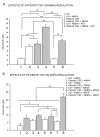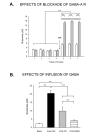In vivo effects of antibodies from patients with anti-NMDA receptor encephalitis: further evidence of synaptic glutamatergic dysfunction
- PMID: 21110857
- PMCID: PMC3002330
- DOI: 10.1186/1750-1172-5-31
In vivo effects of antibodies from patients with anti-NMDA receptor encephalitis: further evidence of synaptic glutamatergic dysfunction
Abstract
Background: A severe encephalitis that associates with auto-antibodies to the NR1 subunit of the NMDA receptor (NMDA-R) was recently reported. Patients' antibodies cause a decrease of the density of NMDA-R and synaptic mediated currents, but the in vivo effects on the extracellular glutamate and glutamatergic transmission are unknown.
Methods: We investigated the acute metabolic effects of patients' CSF and purified IgG injected in vivo. Injections were performed in CA1 area of Ammon's horn and in premotor cortex in rats.
Results: Patient's CSF increased the concentrations of glutamate in the extracellular space. The increase was dose-dependent and was dramatic with purified IgG. Patients' CSF impaired both the NMDA- and the AMPA-mediated synaptic regulation of glutamate, and did not affect the glial transport of glutamate. Blockade of GABA-A receptors was associated with a marked elevation of extra-cellular levels of glutamate following a pretreatment with patients' CSF.
Conclusion: These results support a direct role of NMDA-R antibodies upon altering glutamatergic transmission. Furthermore, we provide additional evidence in vivo that NMDA-R antibodies deregulate the glutamatergic pathways and that the encephalitis associated with these antibodies is an auto-immune synaptic disorder.
Figures






References
-
- Dalmau J, Tuzun E, Wu HY, Masjuan J, Rossi JE, Voloschin A, Baehring JM, Shimazaki H, Koide R, King D, Mason W, Sansing LH, Dichter MA, Rosenfeld MR, Lynch DR. Paraneoplastic anti-N-methyl-D-aspartate receptor encephalitis associated with ovarian teratoma. Ann Neurol. 2007;61:25–36. doi: 10.1002/ana.21050. - DOI - PMC - PubMed
Publication types
MeSH terms
Substances
Grants and funding
LinkOut - more resources
Full Text Sources
Other Literature Sources
Medical
Miscellaneous

